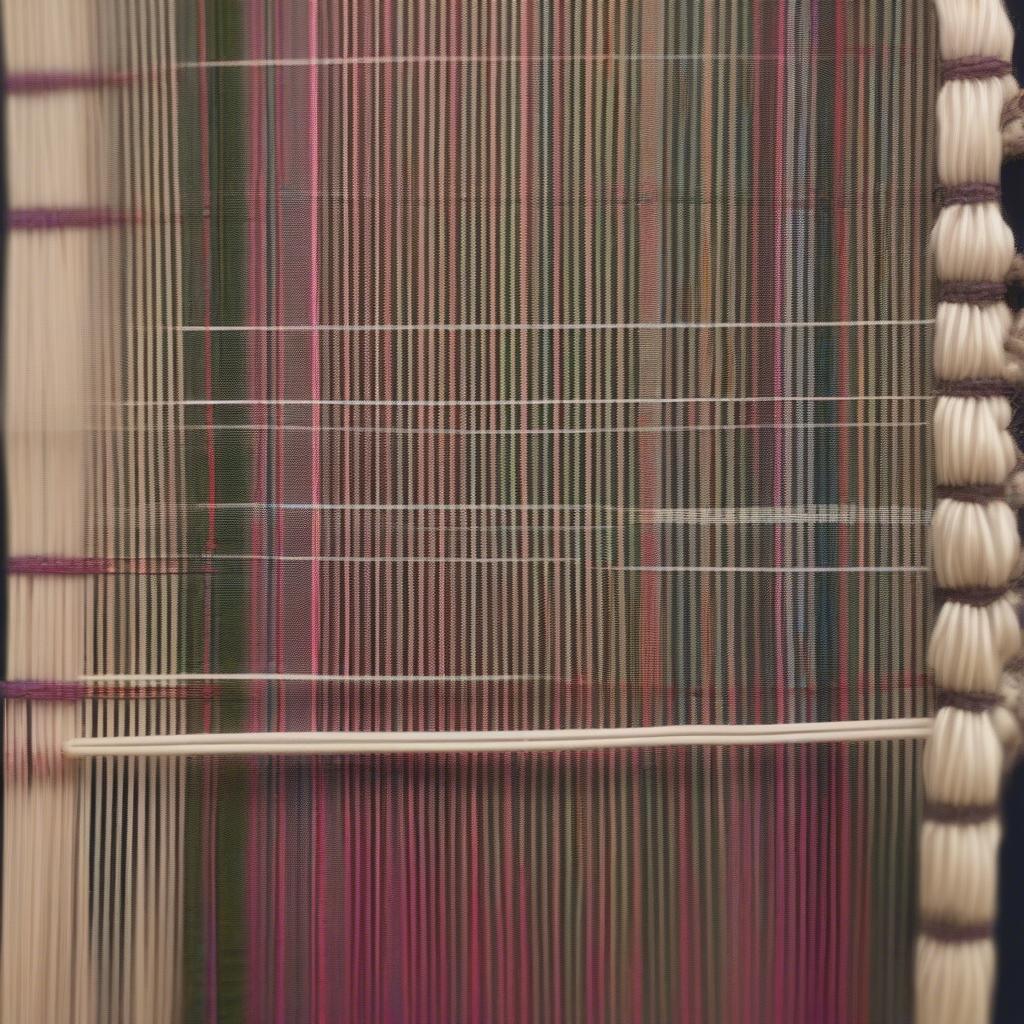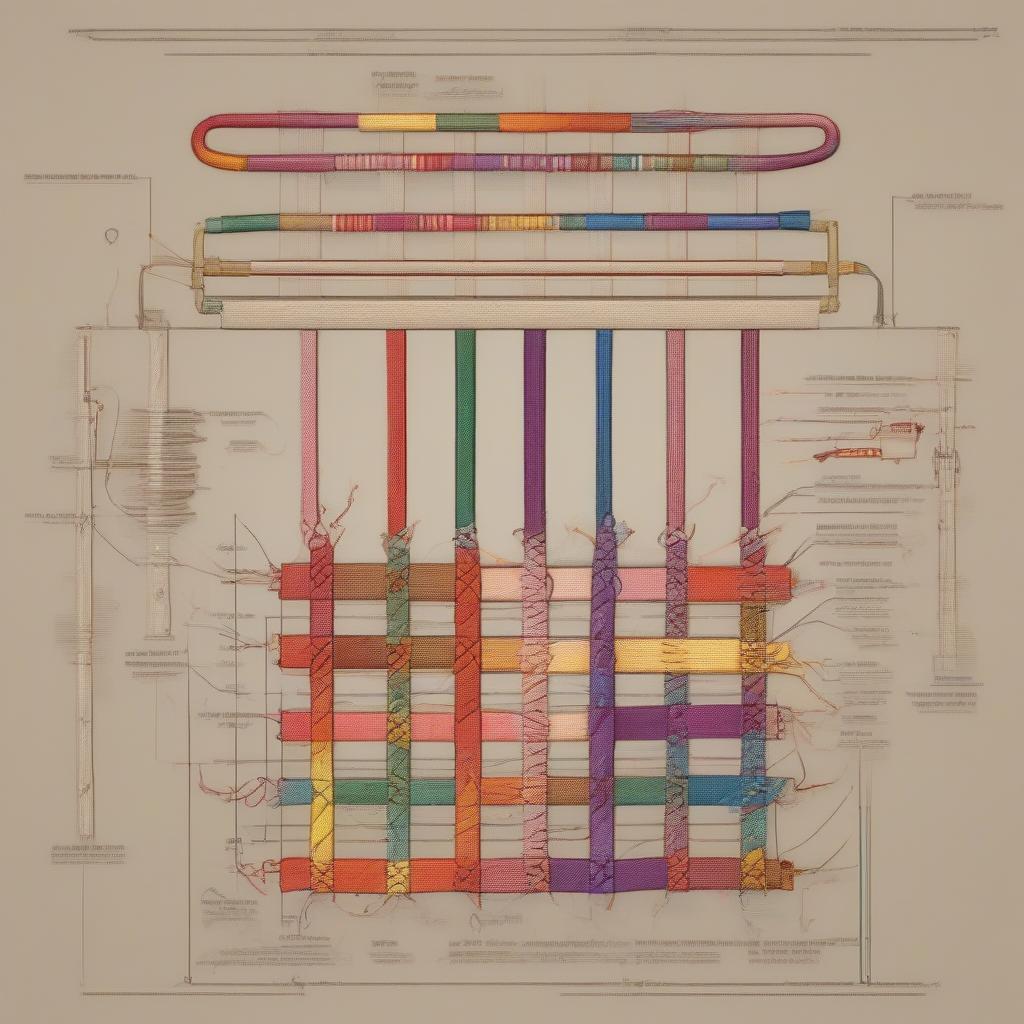Weave Table
Mastering the Art of Table Runner Weaving Drafts
Creating a stunning table runner begins with a well-designed weaving draft. A Table Runner Weaving Draft is essentially the blueprint for your weaving project, dictating the pattern, texture, and overall look of your finished piece. Understanding how to read and manipulate these drafts is key to unlocking a world of creative possibilities. Let’s explore the fascinating world of table runner weaving drafts and how they can transform your weaving projects. weaving draft table runner
Decoding the Secrets of a Weaving Draft
Weaving drafts can appear complex at first glance, but with a little guidance, they become surprisingly accessible. A draft is typically represented as a grid, with each square representing a specific intersection of warp and weft threads. The arrangement of these intersections determines the final woven pattern. Understanding the different components of a draft – the warp, weft, threading, tie-up, and treadling – is crucial for successfully interpreting and implementing a design.
Understanding Warp and Weft
The warp threads run lengthwise on the loom, providing the foundation for your weaving. The weft threads are passed over and under the warp threads, creating the woven fabric. The interaction between these two sets of threads, as dictated by the weaving draft, brings your table runner pattern to life.
 Table Runner Weaving Draft Basics
Table Runner Weaving Draft Basics
Threading, Tie-up, and Treadling: The Trifecta of Weaving
The threading draft shows how the warp threads are threaded through the heddles on your loom. The tie-up connects the heddles to the treadles, which you operate with your feet to lift specific groups of warp threads. Finally, the treadling draft specifies the sequence in which you press the treadles, determining the pattern formed by the weft.
 Threading, Tie-up, and Treadling Diagram
Threading, Tie-up, and Treadling Diagram
Designing Your Own Table Runner Weaving Draft
Once you grasp the fundamentals of reading a weaving draft, you can start experimenting with creating your own designs. Begin with simple patterns and gradually increase complexity as you gain confidence. Software programs and online resources can be invaluable tools for designing and visualizing your creations. how to read weaving drafts table loom Don’t be afraid to explore different weaving techniques and incorporate various colors and textures into your designs.
Simple Table Runner Weaving Draft for Beginners
Starting with a simple 4-shaft table loom project can be a great way to learn. A plain weave draft, for instance, creates a classic, timeless look. From there, you can progress to more intricate patterns like twill or overshot. 4 shaft weaving table loom Even simple variations in threading, tie-up, and treadling can yield dramatically different results.
“A well-planned table runner weaving draft is like a recipe for a delicious meal. The right ingredients and precise instructions lead to a beautiful and satisfying outcome,” says renowned weaving expert, Amelia Weaver.
Exploring Different Weaving Techniques for Table Runners
Different weaving techniques can drastically change the look and feel of your table runner. Consider experimenting with techniques like huck lace, which creates intricate openwork patterns, or Swedish lace, known for its decorative edges. Each technique offers unique possibilities for adding texture and visual interest to your project.
Tips for Successful Table Runner Weaving
Choosing the right yarn is essential for a beautiful and durable table runner. Consider the fiber content, weight, and color carefully. A sturdy yarn like cotton or linen is a good choice for a frequently used table runner. craft table for weaving Remember to properly finish your woven piece to prevent fraying and ensure its longevity.
What loom size do I need for a table runner?
The loom size depends on the desired width of your table runner. A smaller table loom is sufficient for narrower runners, while wider runners may require a floor loom.
Can I use multiple colors in my table runner weaving draft?
Absolutely! Using multiple colors can add depth and vibrancy to your design. Plan your color changes carefully within your weaving draft to achieve the desired effect.
“Don’t be afraid to experiment with color and texture. Weaving is a journey of discovery, and each project is an opportunity to learn and grow,” shares weaving instructor, John Carter.
table loom weaving instructions
In conclusion, mastering table runner weaving drafts opens up a world of creative possibilities. By understanding the fundamentals of weaving drafts and experimenting with different techniques and materials, you can create unique and beautiful table runners that enhance your home décor. Remember, the journey of weaving is as rewarding as the finished product.
FAQ
-
What is a table runner weaving draft? A table runner weaving draft is a plan or blueprint that guides the weaving process, dictating the pattern and structure of the finished table runner.
-
What are the key components of a weaving draft? The key components are the warp, weft, threading, tie-up, and treadling.
-
Where can I find table runner weaving drafts? You can find them in weaving books, magazines, online resources, and even design your own.
-
What type of yarn is best for table runners? Sturdy yarns like cotton or linen are recommended for durability.
-
What size loom do I need? The loom size depends on the desired width of your table runner.
-
Can I adjust a weaving draft to create different patterns? Yes, even small adjustments to the threading, tie-up, or treadling can create unique variations.
-
Where can I learn more about weaving? Many online resources, books, and local craft stores offer classes and workshops.
For further information on related topics, you may find our articles on weaving drafts and table loom projects helpful.
Need assistance? Contact our 24/7 customer support hotline at +84 388 951 999. We’re located in Hanoi, Vietnam and Tech Avenue, Suite 12, San Francisco, CA 94105, USA.
